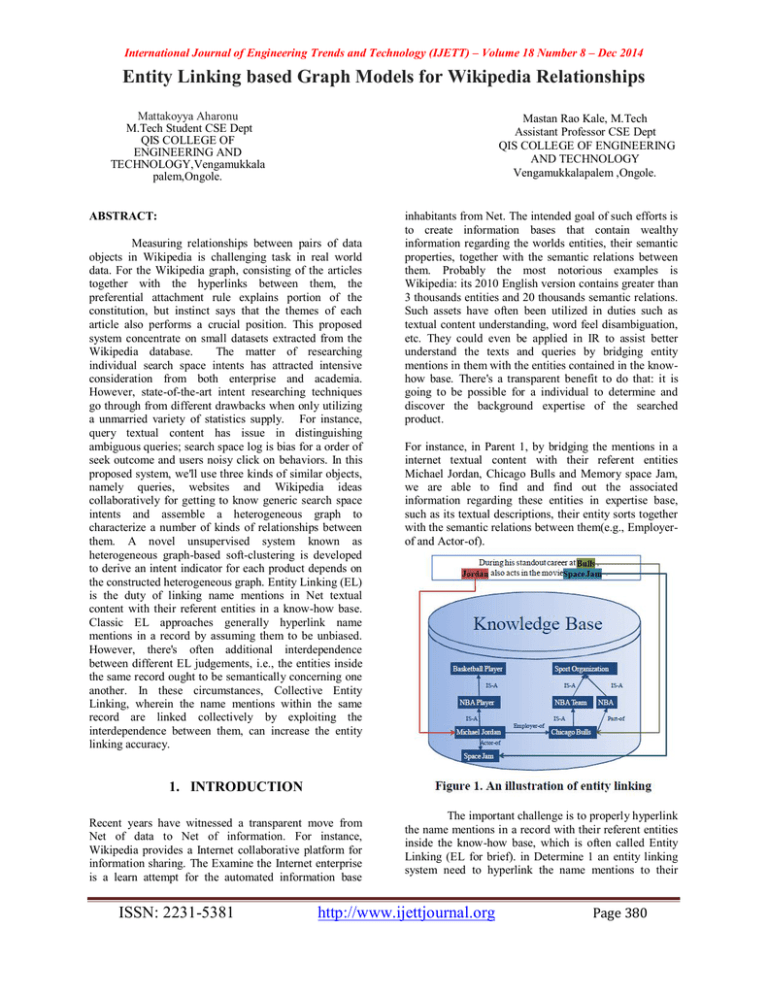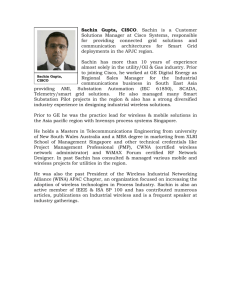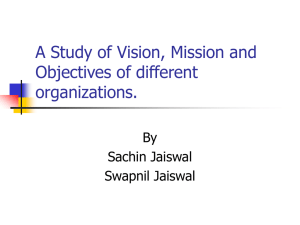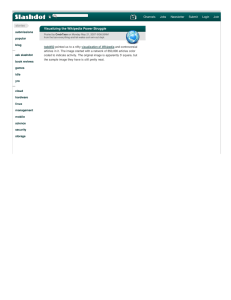Entity Linking based Graph Models for Wikipedia Relationships
advertisement

International Journal of Engineering Trends and Technology (IJETT) – Volume 18 Number 8 – Dec 2014
Entity Linking based Graph Models for Wikipedia Relationships
Mattakoyya Aharonu
M.Tech Student CSE Dept
QIS COLLEGE OF
ENGINEERING AND
TECHNOLOGY,Vengamukkala
palem,Ongole.
Mastan Rao Kale, M.Tech
Assistant Professor CSE Dept
QIS COLLEGE OF ENGINEERING
AND TECHNOLOGY
Vengamukkalapalem ,Ongole.
ABSTRACT:
Measuring relationships between pairs of data
objects in Wikipedia is challenging task in real world
data. For the Wikipedia graph, consisting of the articles
together with the hyperlinks between them, the
preferential attachment rule explains portion of the
constitution, but instinct says that the themes of each
article also performs a crucial position. This proposed
system concentrate on small datasets extracted from the
Wikipedia database.
The matter of researching
individual search space intents has attracted intensive
consideration from both enterprise and academia.
However, state-of-the-art intent researching techniques
go through from different drawbacks when only utilizing
a unmarried variety of statistics supply. For instance,
query textual content has issue in distinguishing
ambiguous queries; search space log is bias for a order of
seek outcome and users noisy click on behaviors. In this
proposed system, we'll use three kinds of similar objects,
namely queries, websites and Wikipedia ideas
collaboratively for getting to know generic search space
intents and assemble a heterogeneous graph to
characterize a number of kinds of relationships between
them. A novel unsupervised system known as
heterogeneous graph-based soft-clustering is developed
to derive an intent indicator for each product depends on
the constructed heterogeneous graph. Entity Linking (EL)
is the duty of linking name mentions in Net textual
content with their referent entities in a know-how base.
Classic EL approaches generally hyperlink name
mentions in a record by assuming them to be unbiased.
However, there's often additional interdependence
between different EL judgements, i.e., the entities inside
the same record ought to be semantically concerning one
another. In these circumstances, Collective Entity
Linking, wherein the name mentions within the same
record are linked collectively by exploiting the
interdependence between them, can increase the entity
linking accuracy.
inhabitants from Net. The intended goal of such efforts is
to create information bases that contain wealthy
information regarding the worlds entities, their semantic
properties, together with the semantic relations between
them. Probably the most notorious examples is
Wikipedia: its 2010 English version contains greater than
3 thousands entities and 20 thousands semantic relations.
Such assets have often been utilized in duties such as
textual content understanding, word feel disambiguation,
etc. They could even be applied in IR to assist better
understand the texts and queries by bridging entity
mentions in them with the entities contained in the knowhow base. There's a transparent benefit to do that: it is
going to be possible for a individual to determine and
discover the background expertise of the searched
product.
For instance, in Parent 1, by bridging the mentions in a
internet textual content with their referent entities
Michael Jordan, Chicago Bulls and Memory space Jam,
we are able to find and find out the associated
information regarding these entities in expertise base,
such as its textual descriptions, their entity sorts together
with the semantic relations between them(e.g., Employerof and Actor-of).
1. INTRODUCTION
Recent years have witnessed a transparent move from
Net of data to Net of information. For instance,
Wikipedia provides a Internet collaborative platform for
information sharing. The Examine the Internet enterprise
is a learn attempt for the automated information base
ISSN: 2231-5381
The important challenge is to properly hyperlink
the name mentions in a record with their referent entities
inside the know-how base, which is often called Entity
Linking (EL for brief). in Determine 1 an entity linking
system need to hyperlink the name mentions to their
http://www.ijettjournal.org
Page 380
International Journal of Engineering Trends and Technology (IJETT) – Volume 18 Number 8 – Dec 2014
corresponding referent entities Chicago Bulls, Michael
Jordan and Area Jam contained in the know-how base.
The entity linking, however, is not a trivial endeavor
because of the name ambiguity challenge, i.e., a
reputation may consult with different entities in several
contexts. For example, the name Michael Jordan can
consult with greater than 20 entities in Wikipedia,
various them are tested below:
Michael Jordan(NBA Participant)
Michael I. Jordan(Berkeley Professor)
Michael B. Jordan(American Actor)
One possible method of signify Wikipedia documents
and relationships is to entice them in a relational
database. This technique allows state-of-the-art queries
inside the type of structured query languages such as
SPARQL and SQL [2]. However, substantial attempt is
required to extract data from Wikipedia and keep it in a
database. Whether or not we consider only data in
infoboxes, a world schema has to be created for each
record magnificence, and each infobox ought to be
mapped into the worldwide schema. As a result of the
large variability in infobox schemas together with the
huge diversity of lessons, this could be challenging.
Another disadvantage of this attitude is usability: it
requires clients to have a-priori expertise of the schema
and to be aware of the query language. It appears
affordable, that incredibly related different types
characterize solid semantic relations. For instance, if a
considerable percent of pages from classification Country
have hyperlinks to classification Capital , we are able to
infer that there need to be a Country to Capital
relationship between the 2 tuples different types.
However, if there are just a couple of hyperlinks between
two different types like Actor and Capital , evidently
there's no steady semantic relationship like Actor to
Capita . We conduct experiments to envision this
filtering system. Within the experiments, we extract a
core set of pages which have a regular topic (in our case
the usual topic is Nations). For these pages we extract
each of the different types they belong to, and likewise
two lists of different types, one for the pages with
hyperlinks in the direction of Nations (inlink pages) and
one for the pages referred by Nations (outlink pages).
The experiments with these lists may give an suggestion
about what hyperlink course is more crucial for semantic
relationship discovery. In the course of the experiments
we experiment two measures used for locating the solid
semantic connections:
1. Diversity of hyperlinks between different types. The
more hyperlinks an improved between pages in two
different types, the stronger need to their semantic
connection be. As we learn individually the result of
outgoing hyperlinks and incoming hyperlinks, every time
only hyperlinks in a single trail are regarded.
2. Connectivity Ratio. We are able to normalize the
variety of hyperlinks with the class dimension, to cut
back the skew towards sizable different types. We call
this normalized valued at Connectivity Ratio, and it
represents the density of linkage between two items (in a
single path).
The semantic relationships inWikipedia have been
outlined in [10]. The authors regarded making use of
ISSN: 2231-5381
hyperlink kinds for search space and reasoning and its
computational feasibility. Its virtue is the incorporation of
semantic facts directly into wiki pages. Later, the
semantic hyperlinks proposal was extended in [12] for a
Semantic Wikipedia vision. In accordance with this kind,
the pages annotations need to contain the subsequent key
aspects: different types, typed hyperlinks, and attributes.
Typed hyperlinks in variety of is capital of are launched
via markup extension [[is capital of::England]], each
hyperlink might be assigned a number of kinds. In
addition they applied the utilization of semantic
templates, depends on the existing Wikipedia templates.
We adjust to this technique, but think about computerized
extraction instead of manual hyperlink activity. Also, our
goal is to permit better seek on Wikipedia, but not to
supply means for full-fledged reasoning. So we are able
to tolerate upper stage of inconsistency in annotations
and use ill-defined schemas. The system for semantic
wiki authoring is launched in [2]. It aids clients in
specifying hyperlink sorts, while coming into the wiki
textual content.
2. LITERATURE SURVEY
Consider the query find Countries which had Democratic
Non-Violent Revolutions. When we search in full-text for
Country Revolution Democracy we get a lot of pages,
which contain all the keywords, but most of them do not
talk about particular countries. In a database-like view,
the target page of our query should belong to the
Countries category, and it should have a connection to a
page in the category Revolutions
which
mentions
the
word
Democracy.
In
currentWikipedia, there is actually a link between the
pages Ukraine and Orange Revolution. If we put into a
separate inverted list1 all pages with Country to
Revolution link type, we can force the previous query to
return more relevant results.
However, it is infeasible to maintain and index all
possible links betweenWikipedia categories. An example
of typical Wikipedia linkage between categories is shown
in the Fig. 1. Ovals correspond to categories, squares
contain the lists of pages and arrows show existence of at
least on hyperlink between categories. The category
Republics is pointed by the Female Singers, Egg, and
Non-violent Revolutions categories. It also points to
Capitals in Europe, Spanish-American War People and
Non-violent Revolutions categories. Some of these links
can be converted into strong semantic relationships, like
“Republics to Non-violent Revolutions” categories, while
relationships like “Egg to Countries” are not regular
semantic connections and only used for navigation or
some unimportant purposes. It is useless to type and
index
such
“LinkSourceCatergory
to
LinkTargetCategory” relationships, as they cannot help
users in search. Instead, we need to filter out unimportant
links and extract semantically significant relationships
from Wikipedia. This could be achieved by analyzing the
link density and link structures between the categories.
Besides search, the prominent semantic relationships can
http://www.ijettjournal.org
Page 381
International Journal of Engineering Trends and Technology (IJETT) – Volume 18 Number 8 – Dec 2014
be of use in template generation and data cleaning. For
example, if we have some pages in Countries without
link to pages in Capitals, the system could suggest users
to add missing link.
Many prior researches on semantic computation with
Wikipedia structure can only compute the tightness of the
relationship between two concepts but not give which
kind of relationship it is [Ollivier and Senellart, 2007;
Adafre and de Rijke, 2005; Milne, 2007; Hu et al., 2009].
This is partly due to the fact that most of these work are
originated from information retrieval in which the articles
and links on wikipedia are analogous to the pages and
links on the web, which do not seize the specialty of
Wikipedia stucture.
Another related area of our work is computing semantic
relatedness using Wikipedia. WikiRelate! [Strube and
Ponzetto, 2006] is the first approach one this area. Given
a pair of words w1 and w2, WikiRelate! first maps them
to Wikipedia titles p1 and p2 and then compute semantic
relatedness using various traditional methods which rely
on either the content of articles or path distances in the
category
hierarchy
ofWikipedia.
Different
fromWikiRelate!,
theWikipedia
Link
Vector
Model(WLVM) [Milne, 2007] represents each article by
a weighted vector of anchor texts and the weights are
given by a measure similar to tf-idf. ESA [Gabrilovich
and Markovitch, 2007] is another semantic relatedness
measure which achieve good results in correlation with
human judgments. ESA represents each text as a
weighted vector of Wikipedia-based concepts and assess
the relatedness on concept space using conventional
metrics. In collaborate filtering, Breese et al.[1998]
proposed a memory-based algorithm for predicting user’s
rating, which looks similar to RCRank if users and items
are considered as concepts and categories. The rating
score of a user on an item is computed from the weighted
average scores of similar users. The weight of each
similar user can be given by cosine similarity on their
previous rating on other items. The main difference is
this algorithm compute the relatedness in one
relation(user-item) while RCRank mutually compute the
relatedness between two relations.
Figure 1 depicts our framework for relation extraction.
First, articles are processed to remove HTML tags and to
extract hyperlinks that point to other Wikipedia articles.
Text is then submitted to a pipeline including a Sentence
ISSN: 2231-5381
Splitter, a Tokenizer, and a Phrase Chunker (an NLP
module to split a sentence into difference phrases such as
noun phrase, verb phrase and so on). The instances of the
principal entity and secondary entities are then anchored
in the articles. The Secondary Entity Detector simply
labels the appropriate surface texts of the hyperlinks to
otherWikipedia articles, which are proper nouns as
secondary entities. The Principal Entity Detector will be
explained in the following subsection.
Preprocessor
The preprocessor converts the raw Wikipedia text into a
sequence of sentences, attaches NLP annotations, and
builds synonym sets for key entities.
Sentence Splitting: The preprocessor first renders each
Wikipedia article into HTML, then splits the article into
sentences using OpenNLP.
NLP Annotation:
Depending on which version is being trained, the
preprocessor uses OpenNLP to supply POS tags and NPchunk annotations or uses the Stanford Parser to create a
dependency parse. When parsing, we force the
hyperlinked anchor texts to be a single token by
connecting the words with an underscore; this
transformation improves parsing performance in many
cases.
Matcher
The matcher constructs training data for the learner
component by heuristically matching attribute-value pairs
from Wikipedia articles containing infoboxes with
corresponding sentences in the article.
For n=0 to EndOfSentence
For i=0 to sum of Sentence
Child[] = Create_TreeInWiki( )
For r=0 to End-Of-Child
For k=0 to End-Of-Word
If Child[r] == Any_WordOf_W
Graph[] = CreateOrUpdateGraph( )
Endif
EndFor
EndFor
EndFor
EndFor
In the above technique, Child represents the children of
the word_tree in the Wikipedia set, and Graph represents
the
constructed_graph
from
the
set
of
http://www.ijettjournal.org
Page 382
International Journal of Engineering Trends and Technology (IJETT) – Volume 18 Number 8 – Dec 2014
wikepedia_sentences to target word. This technique is
proposed for all target_words in the input messages or
entities.
(i) Start with f = {}.
(ii) Select the first two tokens list as specified in the input
for f: the proper of the article_title and the first proper
chunk in the first_sentence of the given entity topic, if
any. These are the first two entities of the primary
entities.
If F is empty,
Then stop.
else
(iii) For each remaining proper_chunk p in the relations,
if p is derived from any relations selected in (ii),
then F ← p.
Proper relation p1 is derived from proper relation p2 if
all its proper relations appear in p2.
(iv) In the set of relationships, select c as the most
frequent subjective_relations, find c’ as its equivalent
objectiv\_relations and add them to f.
(v) For each relation token p with the similarity pattern
Det[N1 . . . Nk] where Det is a determiner and Ni’s are
common_nouns, if p appears most frequently than
remaining all the selected relational pronouns in the (iv),
then F ← p.
5. EXPERIMENTAL RESULTS
All experiments were performed with the configurations
Intel(R) Core(TM)2 CPU 2.13GHz, 2 GB RAM, and the
operation system platform is Microsoft Windows XP
Professional (SP2). Kddcup 99 dataset is used for
network intrusion detection.
Experimental results:
Entity One: Sachin
Entity Two: USA
<?xml version="1.0"?><api><query-continue><allpages
apcontinue="Sachsen" /></querycontinue><warnings><query
ISSN: 2231-5381
xml:space="preserve">Formatting of continuation data
will be changing soon. To continue using the current
formatting, use the 'rawcontinue' parameter. To begin
using the new format, pass an empty string for 'continue'
in the initial
query.</query></warnings><query><allpages>"1126607
" EntityMatch="Sachin" />"42382589"
EntityMatch="Sachin! Tendulkar Alla" />"7332849"
EntityMatch="Sachin, Gujarat" />"13141880"
EntityMatch="Sachin, Pas-de-Calais" />"40688553"
EntityMatch="Sachin-Jigar" />"35658803"
EntityMatch="Sachin:A Hundred Hundreds"
/>"42453356" EntityMatch="Sachin:A Hundred
Hundreds Now" />"35658695" EntityMatch="Sachin: A
Hundred Hundreds Now" />"3364974"
EntityMatch="Sachin (Princely State)" />"10730502"
EntityMatch="Sachin (actor)" />"30616105"
EntityMatch="Sachin (disambiguation)" />"3081004"
EntityMatch="Sachin (princely state)" />"42370015"
EntityMatch="Sachin - Jigar" />"620811"
EntityMatch="Sachin Ahir" />"38145512"
EntityMatch="Sachin Anil Punekar" />"38719115"
EntityMatch="Sachin Baby" />"42182160"
EntityMatch="Sachin Bansal" />"33830608"
EntityMatch="Sachin Bhatt" />"11017085"
EntityMatch="Sachin Bhowmick" />"11017313"
EntityMatch="Sachin Bhowmik" />"36842646"
EntityMatch="Sachin Chaudhary" />"14865689"
EntityMatch="Sachin Dev (S. D.) Burman"
/>"39589936" EntityMatch="Sachin Dev Burman"
/>"39497409" EntityMatch="Sachin Dev
Burman/version 2" />"39497444" EntityMatch="Sachin
Dev Burman/version 3" />"43339418"
EntityMatch="Sachin Garg" />"39126928"
EntityMatch="Sachin Gawas" />"14693433"
EntityMatch="Sachin Gupta" />"20645509"
EntityMatch="Sachin Gupta (musician)" />"31911909"
EntityMatch="Sachin H. Jain" />"5808145"
EntityMatch="Sachin INA" />"39817282"
EntityMatch="Sachin Joab" />"42454003"
EntityMatch="Sachin K. Sanghvi" />"20817418"
EntityMatch="Sachin Khedekar" />"40416113"
EntityMatch="Sachin Khurana" />"35319387"
EntityMatch="Sachin Kundalkar" />"9353336"
EntityMatch="Sachin Nag" />"24397902"
EntityMatch="Sachin Nair" />"38608061"
EntityMatch="Sachin Nayak" />
<?xml version="1.0"?><api><query-continue><allpages
apcontinue="USA-Swaziland_relations" /></querycontinue><warnings><query
xml:space="preserve">Formatting of continuation data
will be changing soon. To continue using the current
formatting, use the 'rawcontinue' parameter. To begin
using the new format, pass an empty string for 'continue'
in the initial
query.</query></warnings><query><allpages>"31873"
EntityMatch="USA" />"20083735"
EntityMatch="USA!" />"42776327"
EntityMatch="USA! (chant)" />"42776338"
EntityMatch="USA! (cheer)" />"42776351"
http://www.ijettjournal.org
Page 383
International Journal of Engineering Trends and Technology (IJETT) – Volume 18 Number 8 – Dec 2014
ISSN: 2231-5381
EntityMatch="USA-233" />"35415089"
EntityMatch="USA-234" />"41970839"
EntityMatch="USA-239" />"38013240"
EntityMatch="USA-240" />"38958112"
EntityMatch="USA-241" />"36385667"
EntityMatch="USA-242"/>
Performance Analysis:
Tim e Access in Existing and Proposed
Retrieval Time
EntityMatch="USA! chant" />"42776353"
EntityMatch="USA! cheer" />"28907235"
EntityMatch="USA&#039;s Strongest Man"
/>"36402576" EntityMatch="USA-1" />"36402612"
EntityMatch="USA-10" />"36389043"
EntityMatch="USA-100" />"36389073"
EntityMatch="USA-117" />"36389090"
EntityMatch="USA-126" />"36389105"
EntityMatch="USA-128" />"36392344"
EntityMatch="USA-132" />"36389169"
EntityMatch="USA-135" />"36392498"
EntityMatch="USA-145" />"36392523"
EntityMatch="USA-150" />"36392542"
EntityMatch="USA-151" />"36392611"
EntityMatch="USA-154" />"36392640"
EntityMatch="USA-156" />"6047160"
EntityMatch="USA-165" />"36392695"
EntityMatch="USA-166" />"36392705"
EntityMatch="USA-168" />"36392716"
EntityMatch="USA-175" />"36392884"
EntityMatch="USA-177" />"36392892"
EntityMatch="USA-178" />"36392923"
EntityMatch="USA-180" />"36392975"
EntityMatch="USA-183" />"35454003"
EntityMatch="USA-184" />"21284605"
EntityMatch="USA-187" />"21284612"
EntityMatch="USA-188" />"21284614"
EntityMatch="USA-189" />"19181115"
EntityMatch="USA-19" />"36393120"
EntityMatch="USA-190" />"36393145"
EntityMatch="USA-192" />"15451849"
EntityMatch="USA-193" />"13927580"
EntityMatch="USA-195" />"36393383"
EntityMatch="USA-196" />"36393632"
EntityMatch="USA-199" />"36498092"
EntityMatch="USA-1 (disambiguation)" />"2943855"
EntityMatch="USA-1 (monster truck)" />"36402572"
EntityMatch="USA-1 (satellite)" />"11840748"
EntityMatch="USA-1 (truck)" />"17420783"
EntityMatch="USA-200" />"17420797"
EntityMatch="USA-201" />"21029233"
EntityMatch="USA-202" />"36393961"
EntityMatch="USA-203" />"41054464"
EntityMatch="USA-204" />"22493077"
EntityMatch="USA-205" />"23992884"
EntityMatch="USA-206" />"24179878"
EntityMatch="USA-207" />"41054659"
EntityMatch="USA-211" />"18727507"
EntityMatch="USA-212" />"27432203"
EntityMatch="USA-213" />"28383633"
EntityMatch="USA-214" />"35408823"
EntityMatch="USA-215" />"33923964"
EntityMatch="USA-221" />"29731780"
EntityMatch="USA-223" />"30577140"
EntityMatch="USA-224" />"30811491"
EntityMatch="USA-225" />"30964384"
EntityMatch="USA-226" />"31581167"
EntityMatch="USA-227" />"31581653"
EntityMatch="USA-229" />"34202909"
EntityMatch="USA-230" />"32299631"
EntityMatch="USA-231" />"36402772"
EntityMatch="USA-232" />"34430502"
40
ExistingAppro
ach
30
20
ProposedAppr
oach
10
0
Sample1 Sample2 Sample3
Sam ples
35
30
25
20
15
10
5
0
ExistingApproach
ProposedApproach
Sample1
Sample2 Sample3
6
CONCLUSION
Entity Linking (EL) is the task of linking name mentions in
Web text with their referent entities in a knowledge base.
Traditional EL methods usually link name mentions in a
document by assuming them to be independent. However,
there is often additional interdependence between different
EL decisions, i.e., the entities in the same document should
be semantically related to each other. In these cases,
Collective Entity Linking, in which the name mentions in the
same document are linked jointly by exploiting the
interdependence between them, can improve the entity
linking accuracy.
7 REFERENCES
1.
Wikipedia,
the
Free
Encyclopedia.
http://wikipedia.org, accessed in 2006.
2. David Aumueller. SHAWN: Structure Helps a Wiki
Navigate. In Proceedings of BTW Workshop WebDB
Meets IR, March 2005.
3. Francesco Bellomi and Roberto Bonato. Network
Analisis for Wikipedia. In Proceedings of Wikimania
2005, The First International Wikimedia Conference.
Wikimedia Foundation, 2005.
http://www.ijettjournal.org
Page 384
International Journal of Engineering Trends and Technology (IJETT) – Volume 18 Number 8 – Dec 2014
4. Abraham Bookstein, Vladimir Kulyukin, Timo Raita,
and John Nicholson. Adapting Measures of Clumping
Strength to Assess Term-Term Similarity. Journal of the
American Society for Information Science and
Technology, 54(7):611–620, 2003.
5. Sergey Brin and Lawrence Page. The Anatomy of a
Large-scale Hypertextual Web Search Engine. Computer
Networks and ISDN Systems, 30(1–7):107–117, 1998.
6. Ludovic Denoyer and Patrick Gallinari. The Wikipedia
XML Corpus. Technical report, 2006.
7. Daniel Kinzler. WikiSense — Mining the Wiki. In
Proceedings of Wikimania 2005, The First International
Wikimedia Conference. Wikimedia Foundation, 2005.
8. Jon Kleinberg. Authoritative sources in a hyperlinked
environment. Technical Report RJ 10076, IBM, 1997.
[10] V. Hristidis, L. Gravano, and Y. Papakonstantinou.
Efficient IR-style keyword search over relational
databases. In VLDB, pages 850–861, 2003.
[11] V. Hristidis and Y. Papakonstantinou. Discover:
keyword search in relational databases. In VLDB, pages
670–681,
2002.
[12] K. Järvelin and J. Kekäläinen. IR evaluation
methods for retrieval”
Author 1:
Mattakoyya Aharonu
M.Tech Student CSE Dept
QIS COLLEGE OF ENGINEERING AND
TECHNOLOGY,
Vengamukkalapalem ,Ongole
Author 2:
Mastan Rao Kale, M.Tech
Assistant Professor CSE Dept
QIS COLLEGE OF ENGINEERING AND
TECHNOLOGY,Vengamukkalapalem,ongole
ISSN: 2231-5381
http://www.ijettjournal.org
Page 385




